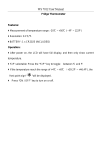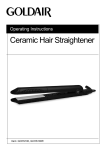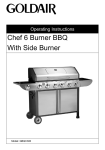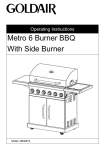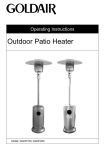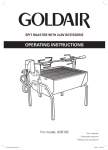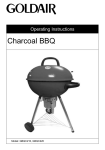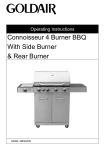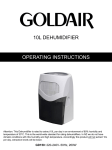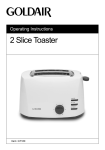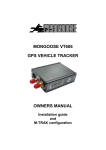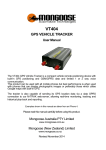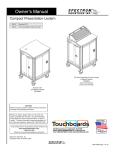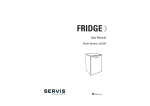Download Manual - Goldair
Transcript
Operating Instructions 42L Chest Fridge Model: GPF42 Read Me First Page 1 Chest Fridge Please read these instructions & user manual carefully. o Before attempting to assemble your Goldair Chest Fridge, ensure all parts are correct and contained within the box as per the components list. o Goldair suggests laying out all components on a large flat surface and removing any plastic or protective material before assembling your Chest Fridge. o It is vital for optimum use of the Chest Fridge that you Purge the gas line prior to attempting to ignite the Chest Fridge. o Do not dispose of packaging until completely satisfied with assembly of your Chest Fridge Please refer to your user manual for operating instructions, further information or trouble shooting before you call the Customer Service number listed within the user manual. Failure to store appropriately, clean & maintain your Chest Fridge regularly will consequently result in it not be covered by the warranty. Read Me First Page 2 Gas Leak Testing It is important that you leak test the Gas Cylinder before first use with the Chest Fridge and every time the gas cylinder is refilled and reconnected to the Chest Fridge. To complete a Leak Test: • Make sure all the control knobs are OFF. • In a small container, mix up a solution of water and detergent/soap. Mix the solution well (about the same concentration as washing up water). • Turn the cylinder ON by rotating the knob to the open position. • Using a brush or spray bottle apply the soap solution to the gas line and each join in the gas line including: • The gas connection at the inlet of the Chest Fridge • The gas hose • The gas connection at the gas cylinder • If bubbles appear, there is a gas leak. • If the leak is at the connection, re-tighten and re-seal. • If the leak is anywhere else or you cannot resolve the leak by tightening the connection DO NOT PROCEED. • Replace gas hose and regulator. • Replacement hose and regulators can be purchased from your local BBQ retail specialist. Read Me First Page 3 Purging The Gas Line It is very important to purge the line free from air to get the LPG to the head unit. o o o o o o o Turn off LPG Cylinder. Disconnect LPG Cylinder. Turn the gas burner knob on for a minute or so releasing air from the line. Turn off burner knob. Reconnect the LPG Cylinder. Turn the dial on the LPG Cylinder SLOWLY to the on position. Press the control knob in allowing gas to come up the line and bleed it (pressing control knob in) for not more than 1 - 2 minutes or until you smell gas. o A five minute complete shut off period is necessary before lighting. If a new tank has just been connected, please allow at least one minute for the air in the gas pipeline to purge out at the High position. A five minute complete shut off period is necessary before lighting. Safety Guide ALWAYS ✔ Leave the fridge to stand for at least 4 hours before switching on to allow gas to settle if transported horizontally. Page 4 NEVER ✘ Do not connect the appliance to the electricity or gas supply until all packing materials have been removed. ✔ Supervise children to ensure they do not ✘ This appliance should not be used by play with the appliance. Close attention is children or infirm persons without necessary when used or placed near supervision. children. ✘ Never move the fridge by pulling on the ✔ Use the appliance only as described in power cord or gas connection. Do not pull this manual and only for its intended the cord to disconnect from an outlet. Keep purpose – that is, the cooling and storing of cord away from heated surfaces and edible foodstuffs and beverages. Use only inspect regularly for damage. If the supply manufacturer's supplied and cord or gas connection is damaged, it must recommended attachments. be replaced by the manufacturer or its service agent or a similarly qualified person ✔ Put the fridge away after use to prevent in order to avoid a hazard. accidents. ✘ Do not handle the plug or appliance with ✔ Empty any water, condensation or liquid wet hands. from the fridge after use, do not let liquid sit in the bottom of the fridge for any length of ✘ Do not put any object into exhaust grill. time. Do not use this appliance if the exhaust ✔ Keep these instructions in a safe place grill is blocked. Keep grill free of dust and for easy reference. lint. ✔ Disconnect the fridge from power outlet ✘ Do not dispose of the appliance on a by grasping the plug and pulling. fire. Your appliance contains non CFC substances in the insulation which are potentially flammable if exposed to fire. Suitable for camping use The appliance may be connected to more than one energy source The appliance must be disposed of safely. Please refer local requirement for disposal Parts Diagram 1.Side Handles 2.Control Dials 3.Grill 4.Fridge Lid 5.12V DC Plug 6.Gas Hose & Regulator Page 5 6 3 2 4 5 1 Transporting • • • • This appliance should be transported only in a vertical upright position. The packing as supplied must be intact during transportation. If during the course of transport the appliance has been transported horizontally, it MUST NOT be operated for at least 4 hours to allow the system to settle. Failure to comply with the above instructions could result in damage occurring to the appliance. Goldair will not be held responsible if these instructions are disregarded. The appliance must be protected from rain, moisture and other atmospheric influences. • IMPORTANT: This appliance is not designed for stacking with any other appliance. • DO NOT attempt to sit or stand on top of your appliance as it is not designed for such use. You could injure yourself or damage the appliance. Such damage and injury is not covered by warranty. • IMPORTANT: Make sure that the power cable is not caught under the appliance during and after carrying/moving the appliance, to avoid the power cable becoming cut or damaged. Operating your Fridge Page 6 This appliance is designed to keep already cold foods chilled, not to cool down warm food. • • • • • • • • • • • • Before using your Chest fridge for the fist time, check that: All packing materials and transit protectors have been removed. The appliance is on a flat, level surface The interior is dry and air can circulate freely. Clean the interior as recommended under “Cleaning and Care”. Insert the plug into a power outlet and switch on the electricity supply. Set the desired thermostat level. A neon POWER indicator light comes on. The liquid and gases sealed within the refrigeration system may give rise to noise, THIS IS NORMAL. Do not immediately load the appliance when it is switched on. Ensure there is adequate space between each item in the fridge for air circulation. Items stored in the fridge should only be placed in if they are at room temperature. Do not place hot items in the fridge. Do not store explosive or flammable items in the fridge. Always use plastic containers and bottles for storing food/beverages Avoid placing your Chest Fridge directly alongside any heat source or in direct sunlight as this will cause it to run for long periods. If located next to a source of heat maintain the following minimum side clearances: * From cookers 100mm * From radiators 300mm * From freezers or other refrigerators 100mm • Ensure that sufficient space is provided around the fridge to allow, obstruction-free air circulation. Operation with 240V plug • IMPORTANT: Never use more than one energy source at a time • Verify that the mains voltage corresponds to the operating voltage specified on the technical data label at the back of the appliance. If the electrical specifications are correct, place the plug into a wall socket. Turn the 240V thermostat knob (left) clockwise to position MAX. After about one hour the effects of the cooling process become visible: frost on the inside evaporator. The thermostat enables the temperature of the chest fridge to be adjusted. After a cooling period of approx. 5 hours, the thermostat can be set on a desired position; this position is influenced by the surrounding temperature and the intensity of use. At the position MIN. the cooling process is stopped. The appliance is switched off by removing the plug from the wall socket. • • • Operating your Fridge Page 7 Operation with 12V plug • • • • • • • • IMPORTANT: Never use more than one energy source at a time A safety fuse must be installed in the power supply line between the battery and the mobile fridge. It is not necessary to check the polarity when starting up the appliance. Verify the voltage of the battery with the voltage indicated on the technical data label at the back of the appliance. When the appliance is powered by a car battery, only switch the mobile fridge on while the car is travelling. If the appliance remains switched on when the car is stopped, the battery charge will be drained very quickly. When using a battery as a power source, there is no thermostatically controlled temperature regulation. Pre-cool the mobile fridge on the mains before starting a journey and try to put only pre-cooled products in the mobile fridge. To start up the unit, connect the supplied cable at the back in the 12V socket and put the corresponding side into the cigar lighter socket of the vehicle. To disconnect, remove the connector from the cigar lighter socket. Operation with LPG gas bottle • • • • • • IMPORTANT: Never use more than one energy source at a time Operation on gas is prohibited in closed areas, in vehicles and on boats. The appliance must be used in a well ventilated area when operating on gas. This means that it can also be used under the canopy of a tent if sufficiently ventilated. In all cases the location should be protected from rain and/or splashing. The gas cylinder must be stored in a cool, dry, ventilated area and never in a basement or a cellar. Protect from sunlight and do not expose to high temperatures. The appliance cannot operate at a pressure other than the one specified on the identification label at the back. You must therefore use the appropriate pressure regulator. During connection of the chest fridge to the gas cylinder, always stay clear of any sort of ignition and do not smoke. Connect in the order gas cylinder – pressure regulator – appliance. Excessive twisting and bending of the flexible hose must be avoided. Check for leaks only by means of soapy water. Never check for leaks using a flame. When changing the gas cylinder or disconnecting the hose, it is necessary to close the valve of the gas cylinder. Always replace a damaged or porous hose. Operating your Fridge • 1. 2. 3. Page 8 The gas valve knob (right hand control dial) is a combination of temperature control and ignition. Next to this is the gas valve assembly consisting of an incorporated safety pilot, a burner with an ignition plug and a piezo-electric ignitor. The safety pilot automatically maintains the gas supply as long as it remains lit. It automatically shuts off the supply of gas if the flame goes out. Open the gas valve of the gas cylinder, press the gas valve knob in the panel, wait approx. 15 seconds, turn the pressed knob to the right, a click of the ignitor can be heard and the gas flame is ignited. Hold the knob pressed in this position so that the flame remains burning. It might be possible that this operation has to be repeated a couple of times, especially if the appliance has not been used for a long time or if the gas cylinder has been changed. There can be air in the system, which has to be forced out. It is necessary to check that the pilot is lit by looking through the orifice at the top of the unit or through the hole at the back near the burner. NOTE: If the flame fails to light, wait at least a minute before trying again. • • Leave the knob for some time in max. position; after a sufficiently long cool down period, a lower position can be selected. To disconnect the mobile fridge running on gas: close the valve of the gas cylinder and then turn the gas valve knob in the panel to position ‘press’. Maintenance • • • • • • • • • • Page 9 Ensure the chest fridge is not connected to any electrical or gas supply when cleaning The chest fridge must be defrosted regularly in order to ensure a correct operation. To defrost the appliance, disconnect it, empty it and if necessary use a cloth with hot water. Never immerse the fridge, power cord or plug in water or any other liquid. Ensure no liquid remains in the fridge for any length of time. Dry and clean the inside without using abrasive products. Never use a knife or other sharp tool to remove ice. If the appliance is to remain unused for a longer period, disconnect it, clean it and leave the cover slightly open during storage to prevent unpleasant odours. Put some talcum powder in the gasket of the lid. If after such a period the fridge does not cool down, switch it off again and leave it turned upside down for a few hours. Put it the right way up and connect again. To avoid the risk of electric shock, do not dismantle the fridge. All repairs, if needed, particularly of the cooling unit or the gas burner system, can only be carried out by a qualified electrical or gas technician. Troubleshooting Page 10 Issue Resolution Are all accessories and sources of energy correct? Confirm you are using the correct accessories for the operation used Are the various connections correct? Unplug all connections and reconnect correctly Is the appliance sitting in a horizontal position? If not, turn the fridge off, turn it the correct way up, leave for four hours then turn back on Is there sufficient ventilation around the exterior of the fridge? Remove any items that are blocking airflow around the fridge Is the 12V battery sufficiently charged? If the battery is not charged, disconnect fridge and re-connect to a different battery Is the gas cylinder sufficiently filled? If not, fill the LPG cylinder Has the gas valve knob been pressed long enough when using the gas supply? If not, turn the fridge off, leave for one minute and repeat the ignition procedure Has the thermostat knob been set to max position? If not, turn the fridge off, leave for one minute then turn back on and turn the thermostat to the max position Have 2 modes of operation been selected at the same time? If so, turn the fridge off, leave for one minute then turn back on and turn the thermostat to the max position Is there too much food inside the appliance? If so, remove some items of food to allow better air circulation in the unit One Year Warranty Your Goldair product has been inspected, tested and is guaranteed subject to the following for a period to one year from the date of purchase against defects in workmanship and materials. During this period, such defects will be rectified by repair or replacement of the product purchased. Your Warranty becomes invalid if in our opinion the product has been misused, incorrectly assembled, tampered with, connected to a gas supply not corresponding with the name plate specification, or not regularly maintained as per the “Maintenance” notes at the end of this user manual. The Warranty does not include any labour or other associated expense that may be involved in removal or installation of the product. Normal wear & tear and any issues involving spider/insect web build up’s inside gas lines are expressly excluded. If the product is to be replaced (cannot be repaired) then that replacement will be of the same or similar product or accessory excluding packaging, instruction card etc. Where a replacement product is supplied, this shall be guaranteed for the balance of the original Warranty period. If your Goldair product fails to operate satisfactorily, please contact Goldair via phone in the first instance. To obtain a repair or replacement product under this Warranty, you will need to produce satisfactory evidence of date of purchase. The completed Warranty and purchase receipt must be presented with the product. The Warranty should be filled out at the time of purchase. It is in your interest to make sure this is done. Consumers Guarantee Act (1993). In accordance with the above act, consumers are advised that: The manufacturer does not undertake that repair facilities and parts are necessarily available for this product. If any of the provisions of the foregoing are contrary to any relevant legislation, then that provision shall be deemed to be excluded from the Warranty and the rest of the provisions will continue to apply. Any model that is no longer available will be replaced by a model of a value and with such features as we consider appropriate in the circumstances. Goldair Ltd is not responsible for freight forwarding charges, losses or damage in transit. If service is required after the Warranty period has expired, the product should be inspected by a qualified gas service technician. Service outside of the Warranty period will be at your cost. IMPORTANT: Please retain this Warranty card Name ……………………………………………… Purchased from ………………………………… Address …………………………………………… Date of purchase ………………………………… ………………………………………………………. Name of product ………………………………… Suburb …………………………………………… Model no …………………………………………… TECHNICAL SPECIFICATION Model No: GPF42 Battery 12 v – 90W –7.5 A AC Supply: 230 - 240V 50Hz 85 - 90W 0.38A DC Supply: 12V 90W 7.5A Mains 240v – 50Hz – 90W – 0.38 Amps Gas Type: Butane and Propane Total Gas Consumption: 15g/h VOLUME NET: 42L Refrigerant: NH385g Class: T Isolation: Cyclopetane SUPPORT AND TECHNICAL ADVICE PO Box 100707, NSMC, Auckland, New Zealand Monday – Friday 8am-5pm Phone: 0800 232 633 Website: www.goldair.co.nz













